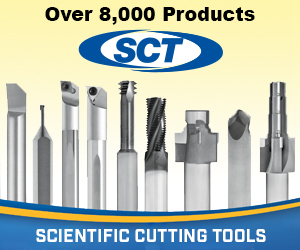Contact Details

Rustlick is excited to announce the release of a new premium, ultra-long lasting semi-synthetic coolant, Ultracut 380R. Ultracut 380R delivers outstanding performance in a wide range of machining and grinding applications.
R&D Chemist, Leroy Hitchcock, explains, "Ultracut 380R uses the newest lubrication and antimicrobial technologies for a coolant that provides an ideal balance of operating performance and durability in the sump."
Ultracut 380R is a number one choice for manufacturers working for industries as diverse as aerospace, automotive, agriculture, energy, industrial components, job shops, plastics, transportation or anyone looking for a maximum performance coolant that lasts. Ultracut 380R reportedly delivers proven resistance to microbials, like bacteria and fungus, and is shown to last longer than competitive coolants without the need for costly additives.
In independent lab studies, Ultracut 380R lasted longer and outperformed top competitors in bacterial and fungal resistance. This hard water stable formula is effective in a wide range of light, moderate and heavy-duty applications, including machining, cutting, grinding, milling, broaching, threading and turning.
"Ultracut 380R is great for aluminum applications because it won't stain the metal like other semi-synthetics," states Hitchcock.
Ultracut 380R contains no DCHA (dicyclohexamine), chlorine, boron, phenol, nitrites, triazines, sulfur, copper, or SARA 313 reportable chemistry and it is easy to recycle or dispose of with conventional techniques and equipment. Rustlick Ultracut 380R is available in 5 or 55 gallon containers and is recommended for ferrous and nonferrous metals, aluminum, titanium, brass, bronze, copper, and other high-nickel alloys.
Related Glossary Terms
- alloys
alloys
Substances having metallic properties and being composed of two or more chemical elements of which at least one is a metal.
- broaching
broaching
Operation in which a cutter progressively enlarges a slot or hole or shapes a workpiece exterior. Low teeth start the cut, intermediate teeth remove the majority of the material and high teeth finish the task. Broaching can be a one-step operation, as opposed to milling and slotting, which require repeated passes. Typically, however, broaching also involves multiple passes.
- coolant
coolant
Fluid that reduces temperature buildup at the tool/workpiece interface during machining. Normally takes the form of a liquid such as soluble or chemical mixtures (semisynthetic, synthetic) but can be pressurized air or other gas. Because of water’s ability to absorb great quantities of heat, it is widely used as a coolant and vehicle for various cutting compounds, with the water-to-compound ratio varying with the machining task. See cutting fluid; semisynthetic cutting fluid; soluble-oil cutting fluid; synthetic cutting fluid.
- gang cutting ( milling)
gang cutting ( milling)
Machining with several cutters mounted on a single arbor, generally for simultaneous cutting.
- grinding
grinding
Machining operation in which material is removed from the workpiece by a powered abrasive wheel, stone, belt, paste, sheet, compound, slurry, etc. Takes various forms: surface grinding (creates flat and/or squared surfaces); cylindrical grinding (for external cylindrical and tapered shapes, fillets, undercuts, etc.); centerless grinding; chamfering; thread and form grinding; tool and cutter grinding; offhand grinding; lapping and polishing (grinding with extremely fine grits to create ultrasmooth surfaces); honing; and disc grinding.
- milling
milling
Machining operation in which metal or other material is removed by applying power to a rotating cutter. In vertical milling, the cutting tool is mounted vertically on the spindle. In horizontal milling, the cutting tool is mounted horizontally, either directly on the spindle or on an arbor. Horizontal milling is further broken down into conventional milling, where the cutter rotates opposite the direction of feed, or “up” into the workpiece; and climb milling, where the cutter rotates in the direction of feed, or “down” into the workpiece. Milling operations include plane or surface milling, endmilling, facemilling, angle milling, form milling and profiling.
- threading
threading
Process of both external (e.g., thread milling) and internal (e.g., tapping, thread milling) cutting, turning and rolling of threads into particular material. Standardized specifications are available to determine the desired results of the threading process. Numerous thread-series designations are written for specific applications. Threading often is performed on a lathe. Specifications such as thread height are critical in determining the strength of the threads. The material used is taken into consideration in determining the expected results of any particular application for that threaded piece. In external threading, a calculated depth is required as well as a particular angle to the cut. To perform internal threading, the exact diameter to bore the hole is critical before threading. The threads are distinguished from one another by the amount of tolerance and/or allowance that is specified. See turning.
- turning
turning
Workpiece is held in a chuck, mounted on a face plate or secured between centers and rotated while a cutting tool, normally a single-point tool, is fed into it along its periphery or across its end or face. Takes the form of straight turning (cutting along the periphery of the workpiece); taper turning (creating a taper); step turning (turning different-size diameters on the same work); chamfering (beveling an edge or shoulder); facing (cutting on an end); turning threads (usually external but can be internal); roughing (high-volume metal removal); and finishing (final light cuts). Performed on lathes, turning centers, chucking machines, automatic screw machines and similar machines.




